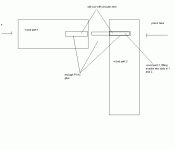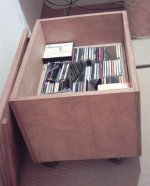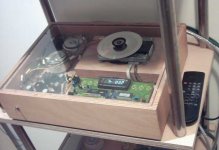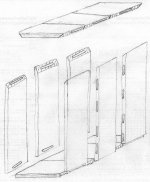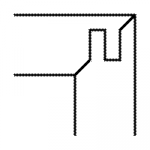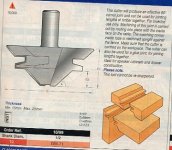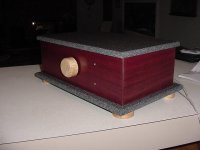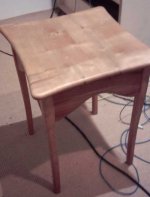I have been building a pair of Pass/Thagard A75 amps for quite a while now. The project has progresssed to the point to where I am considering the construction of wooden cases for the amps. However I am a beginner at woodwork and I'd like to find a buddie or two with woodworking experience who can provide advice.
The amps (two monoblocks) are build on to two L shaped pieces of MFD which will be slid into wooden jackets and the cases completed with aluminium front and rear panels (in the process of being ordered). These pannels are 630mm high and 230mm wide and so the cases will be (roughly) high (630), narrow (230) and deep (830mm). I want to build in solid oak, to match the room the amps will be in.
My knowledge of woodworking is limited to reading the speaker building articles in audioXpress. I think/realise I will have to join two or more pieces of wood to get pieces wide enough for the panels but do not know how to go about it.
And beyond that I'm at a bit of a loss. I do not know what type of joints to use, or which types are within my capability. I realise that I should try to hide the end grain but do not know how to go about doing it. Even if I cannot build it myself and I find someone to build the cases for me I'd still like to know what to ask for and design the joints first.
If you have wookworking skills as well as audio ones I would welcome your suggestions as to how to build cases for my A75's, to a standard so that the cases on the outside match the quality of what is inside.
Regards,
Neil J Mackie.
The amps (two monoblocks) are build on to two L shaped pieces of MFD which will be slid into wooden jackets and the cases completed with aluminium front and rear panels (in the process of being ordered). These pannels are 630mm high and 230mm wide and so the cases will be (roughly) high (630), narrow (230) and deep (830mm). I want to build in solid oak, to match the room the amps will be in.
My knowledge of woodworking is limited to reading the speaker building articles in audioXpress. I think/realise I will have to join two or more pieces of wood to get pieces wide enough for the panels but do not know how to go about it.
And beyond that I'm at a bit of a loss. I do not know what type of joints to use, or which types are within my capability. I realise that I should try to hide the end grain but do not know how to go about doing it. Even if I cannot build it myself and I find someone to build the cases for me I'd still like to know what to ask for and design the joints first.
If you have wookworking skills as well as audio ones I would welcome your suggestions as to how to build cases for my A75's, to a standard so that the cases on the outside match the quality of what is inside.
Regards,
Neil J Mackie.
I build everything with wood:
http://www.diyaudio.com/forums/showthread.php?postid=74640#post74640
http://www.diyaudio.com/forums/showthread.php?postid=155952#post155952
http://www.diyaudio.com/forums/showthread.php?postid=160593#post160593
The simple connection bewteen 2 parts of wood i made in case of the two amps shown is as following. All you need for this is a circular table saw.
http://www.diyaudio.com/forums/showthread.php?postid=74640#post74640
http://www.diyaudio.com/forums/showthread.php?postid=155952#post155952
http://www.diyaudio.com/forums/showthread.php?postid=160593#post160593
The simple connection bewteen 2 parts of wood i made in case of the two amps shown is as following. All you need for this is a circular table saw.
Attachments
Thank to the above for their replies and pictures.
Till, those horns looks lovely. Thank you for your diagram showing how to join using a slot in both pieces with a wooden peg glued into the gap to join them (is my description correct?). This seems similar to the 'biscuit' method described in a number of audioXpress articles, for example 'Building the Thors' in the September 002 issue. However that article lists one of the tools as 'biscuit cutter' and from the illustration it looks like a hand held power tool which cuts a slot from above. Conversely a circular saw (if table mounted) cuts from below and cuts only the width of the saw.
Is your peg the width of your saw cut and if so, is that not rather thin?
Can you advise me on hiding the end grain? For the base I do not mind the end grain showing, it will be on the floor and will be less obvious. However at the top I would prefer to minimise the visual effect of any end grain. Can the edges of the sides and top be cut at 45 degrees and held together with a biscuit? Does such a joint require more experience and skill than I have (to get the edges straight and mating perfectly without any end grain showing)?
Does anyone know the availability of 'biscuits' in the UK, they might just be a US thing that have not reached European shores yet?
I'll try sketching out what I'm considering and post the result. Till then you can see the extent of my woodworking skills at
http://www.n.mackie.btinternet.co.uk/paraglow/article/article.html#introduction
The wooden parts there were professionally cut, dead straight and so fitted well. I doubt if I'd be able to make cuts as good. The joints are also supported internally, being glued to a small piece of wood at each corner. For the A75 cases I want the insides of the case to be as clean as the outside, so no braces or metal brackets and screws, which is why I'm asking/thinking about biscuits or pegs to support the joints.
Regards,
Neil (J Mackie).
Till, those horns looks lovely. Thank you for your diagram showing how to join using a slot in both pieces with a wooden peg glued into the gap to join them (is my description correct?). This seems similar to the 'biscuit' method described in a number of audioXpress articles, for example 'Building the Thors' in the September 002 issue. However that article lists one of the tools as 'biscuit cutter' and from the illustration it looks like a hand held power tool which cuts a slot from above. Conversely a circular saw (if table mounted) cuts from below and cuts only the width of the saw.
Is your peg the width of your saw cut and if so, is that not rather thin?
Can you advise me on hiding the end grain? For the base I do not mind the end grain showing, it will be on the floor and will be less obvious. However at the top I would prefer to minimise the visual effect of any end grain. Can the edges of the sides and top be cut at 45 degrees and held together with a biscuit? Does such a joint require more experience and skill than I have (to get the edges straight and mating perfectly without any end grain showing)?
Does anyone know the availability of 'biscuits' in the UK, they might just be a US thing that have not reached European shores yet?
I'll try sketching out what I'm considering and post the result. Till then you can see the extent of my woodworking skills at
http://www.n.mackie.btinternet.co.uk/paraglow/article/article.html#introduction
The wooden parts there were professionally cut, dead straight and so fitted well. I doubt if I'd be able to make cuts as good. The joints are also supported internally, being glued to a small piece of wood at each corner. For the A75 cases I want the insides of the case to be as clean as the outside, so no braces or metal brackets and screws, which is why I'm asking/thinking about biscuits or pegs to support the joints.
Regards,
Neil (J Mackie).
nmackie,
as i´m no native speaker i tried to describe as good as possible. I don´t know all the words. The little piece of wood is called in german "Feder" whats same as a spring, the slot is called "Nut". So this kind of connection is called "Verbindung mit Nut und eingelegter Feder". This piece is same size as the circular saws blade. The saw blade (300mm Diameter) is usualy 3.2 mm thick (carbide). So its perfect too use a piece of 3mm plywood. I use this connection often because its quick to build and easy to make in good quality. For this 45° solution "auf Gehrung" : its not so easy because pieces dont want to stay in position when you press it together. Whatever they write on the pot with glue: if you want a good and good looking connection you have to press pieces together, long time, very firmly. It is important to use good big fastening clamp with large pieces of wood between clamp and workpiece. I would use the solution with end grain (?) looking to left and right side.
example cd box:
as i´m no native speaker i tried to describe as good as possible. I don´t know all the words. The little piece of wood is called in german "Feder" whats same as a spring, the slot is called "Nut". So this kind of connection is called "Verbindung mit Nut und eingelegter Feder". This piece is same size as the circular saws blade. The saw blade (300mm Diameter) is usualy 3.2 mm thick (carbide). So its perfect too use a piece of 3mm plywood. I use this connection often because its quick to build and easy to make in good quality. For this 45° solution "auf Gehrung" : its not so easy because pieces dont want to stay in position when you press it together. Whatever they write on the pot with glue: if you want a good and good looking connection you have to press pieces together, long time, very firmly. It is important to use good big fastening clamp with large pieces of wood between clamp and workpiece. I would use the solution with end grain (?) looking to left and right side.
example cd box:
Attachments
How does it sound?
I have not much experience and no real good other CDPs to compare. I would say good.
And is the remote working from far?
Very far. No problem from the other room and 2 walls reflecting the signals.
Very original idea with a CD player.
Thanks!
'ideal' case sketched
I sketeched an idea for a case - it should appear below.
It is what I consider the 'ideal' in terms of hiding the end grain, but while drawing it I think there are some drawbacks which I will describe.
The end grain of the base is on the left and right. To get the required dimension a number of short planks have to be joined edge to edge. The disadvantage of this is that, because of the joins, the base is weaker. The amp is heavy, I'm not sure if I can lift it off the bench, and the base will have to support all the weight and therefore is should be strong. So while it would be nice to have the end grain on the left and right of the base, so it gets hidden by the sides, I think the base will have to be one piece of wood with the end grain at the front and back in order to provide maximum strength.
The sides are made of three (or 4 depending on what width I can get) pieces, end grain top and bottom.
The top is shown with the end grain to the right and left, like the base. However, depending on the quality of the joins, it may be better to have a single piece with the end grain front and back. I'd also like to have the option of putting speakers on top of the amp case, so a certain amount of strength is needed, which again favours a single piece of wood.
The case is finished off front and back with aluminium panels which are fitted to the frame of the amp which slides into the case from the front or back.
I would welcome any comments and suggestions.
Regards,
Neil (J Mackie).
I sketeched an idea for a case - it should appear below.
It is what I consider the 'ideal' in terms of hiding the end grain, but while drawing it I think there are some drawbacks which I will describe.
The end grain of the base is on the left and right. To get the required dimension a number of short planks have to be joined edge to edge. The disadvantage of this is that, because of the joins, the base is weaker. The amp is heavy, I'm not sure if I can lift it off the bench, and the base will have to support all the weight and therefore is should be strong. So while it would be nice to have the end grain on the left and right of the base, so it gets hidden by the sides, I think the base will have to be one piece of wood with the end grain at the front and back in order to provide maximum strength.
The sides are made of three (or 4 depending on what width I can get) pieces, end grain top and bottom.
The top is shown with the end grain to the right and left, like the base. However, depending on the quality of the joins, it may be better to have a single piece with the end grain front and back. I'd also like to have the option of putting speakers on top of the amp case, so a certain amount of strength is needed, which again favours a single piece of wood.
The case is finished off front and back with aluminium panels which are fitted to the frame of the amp which slides into the case from the front or back.
I would welcome any comments and suggestions.
Regards,
Neil (J Mackie).
Attachments
Hi Neil
If you have no end grain visible your life gets a lot simpler
You can use veneer ply or mdf, which is much cheaper and stronger than oak, and is relatively easy to get, (Shadwells, down in Barking, comes to mind as a supplier). If the ends need finishing, because your metal front and back don't cover the woodwork, you can get matching iron on veneer in strips for just that purpose.
If you decide to go the solid wood method, making panels with biscuit joints is very straightforward, you just need to make sure you have loads of sash cramps for the glue up. Prepping the wood is not so straight forward tho, you need to make sure each piece has smooth, true, parallel sides, so you will need a good plane for that, and lots of time and practice if you have never planed hardwood before. Or an electric tabletop jointing planer!
You also need to make sure you have no crossgrain situations in your glue up, as the wood expands at differing rates along and across the grain, causing splits and shakes over time.
Another option for the top is to use a mitre lock joint, cut with a special router bit. This gives more glue area than just a biscuited mitre, and has the useful facility of being self aligning, and less likely to slip when clamped. see attached pic
If you have no end grain visible your life gets a lot simpler
You can use veneer ply or mdf, which is much cheaper and stronger than oak, and is relatively easy to get, (Shadwells, down in Barking, comes to mind as a supplier). If the ends need finishing, because your metal front and back don't cover the woodwork, you can get matching iron on veneer in strips for just that purpose.
If you decide to go the solid wood method, making panels with biscuit joints is very straightforward, you just need to make sure you have loads of sash cramps for the glue up. Prepping the wood is not so straight forward tho, you need to make sure each piece has smooth, true, parallel sides, so you will need a good plane for that, and lots of time and practice if you have never planed hardwood before. Or an electric tabletop jointing planer!
You also need to make sure you have no crossgrain situations in your glue up, as the wood expands at differing rates along and across the grain, causing splits and shakes over time.
Another option for the top is to use a mitre lock joint, cut with a special router bit. This gives more glue area than just a biscuited mitre, and has the useful facility of being self aligning, and less likely to slip when clamped. see attached pic
Attachments
First to reply to Sawzall, thank you for the suggestion, however my intent is to have the aluminium panels attached to the MFD that the amp is built on; the wooden case is just a sleeve into which the amp slides. That way I caqn slide the amp out of its case to work on it.
Pinkmouse / Al. Lots of suggestions here, and lost of questions in return.
Veneer ply - is this ply with a veneer already applied? If so I'd consider it, otherwise I'd prefer to stick to solid wood as I do not have _any_ experience of veneering.
Mitre lock joint - I like this idea. The picture shows the cut for a 45 degree joint, but I suppose a similar joint could be used to join planks edge to edge, instead of biscuits. The joint would probably be better and stronger ?
Based on your comments I'm encouraged to take the trouble hide the end grain even if the resulting jointing is more complicated.
I get the feeling that if I'm going to do this myself I'll have to find a way of getting access to a table router in order to get the accuracy of dimension, and quality of edges and cuts necessary. Perhaps if I wait till September I could start an woodworking evening class to get access to equipment.
Thanks to all for their help and suggestions.
Pinkmouse / Al. Lots of suggestions here, and lost of questions in return.
Veneer ply - is this ply with a veneer already applied? If so I'd consider it, otherwise I'd prefer to stick to solid wood as I do not have _any_ experience of veneering.
Mitre lock joint - I like this idea. The picture shows the cut for a 45 degree joint, but I suppose a similar joint could be used to join planks edge to edge, instead of biscuits. The joint would probably be better and stronger ?
Based on your comments I'm encouraged to take the trouble hide the end grain even if the resulting jointing is more complicated.
I get the feeling that if I'm going to do this myself I'll have to find a way of getting access to a table router in order to get the accuracy of dimension, and quality of edges and cuts necessary. Perhaps if I wait till September I could start an woodworking evening class to get access to equipment.
Thanks to all for their help and suggestions.

Hi Neil
Yup, if you want to use mitre lock joints you do need a table router! Yes, the joints are stronger than biscuits, but I have never broken a biscuit yet, so it's a bit academic
Veneer ply is exactly that, good quality cabinet grade plywood with either one or both sides pre-veneered and ready to go. And as I said, veneer mdf is even cheaper.
Your idea of evening classes is a good one, as long as they have a decent workshop, otherwise I would buy your materials and then see if you can find a friendly kitchen/shopfitting firm who would help out.
Below is a pic of a lock mitre cutter, and as you can see, it works for both in line and right angle joints
Yup, if you want to use mitre lock joints you do need a table router! Yes, the joints are stronger than biscuits, but I have never broken a biscuit yet, so it's a bit academic
Veneer ply is exactly that, good quality cabinet grade plywood with either one or both sides pre-veneered and ready to go. And as I said, veneer mdf is even cheaper.
Your idea of evening classes is a good one, as long as they have a decent workshop, otherwise I would buy your materials and then see if you can find a friendly kitchen/shopfitting firm who would help out.
Below is a pic of a lock mitre cutter, and as you can see, it works for both in line and right angle joints
Attachments
Hello Al,
Just a quick comment on your last picture. It looks as if the price of the cutter is £84 . Ok its a clever tool, but the price is about the same cost as the transformers for both my monoblocks. And the note says it cannot be sharpened, so once it is blunt I suppose you just throw it away !
Having thought about it further, the suggestion of veneered ply or MDF only reintroduces the end grain problem. See till's pictures, lots of ply layers visible, which is why I still prefer the solid wood option. However I may have to re-consider when I find out the price of solid oak.
Regards,
Neil (J Mackie).
Just a quick comment on your last picture. It looks as if the price of the cutter is £84 . Ok its a clever tool, but the price is about the same cost as the transformers for both my monoblocks. And the note says it cannot be sharpened, so once it is blunt I suppose you just throw it away !
Having thought about it further, the suggestion of veneered ply or MDF only reintroduces the end grain problem. See till's pictures, lots of ply layers visible, which is why I still prefer the solid wood option. However I may have to re-consider when I find out the price of solid oak.
Regards,
Neil (J Mackie).
If you have seen this http://www.diyaudio.com/forums/showthread.php?postid=155952#post155952
there is no plywood. Its maple, and all surfaced are finished very high quality, so its no problem they are visible.
The other parts are no cheap and simple plywood but some kind of high density plywood. It could be finished very good, have a look at bulthaupt kitchen systems, they use it a lot.
http://www.bulthaup.com/
Oak , solid is not expensive in the amount you will need. It´s about 700€ for 1m^3 - you could build a lot of boxes from 1m^3.
I would avoid using oak for this purpose. This wood is used for coffins, and the only thing it is really good for is barrels for wine; barrique.
A professional tool like that above is not cheap, but without good tools you will not be able to build good quality. In my (private) wood workshop i use tools that would cost some 10000€ if i would need to buy new....
there is no plywood. Its maple, and all surfaced are finished very high quality, so its no problem they are visible.
The other parts are no cheap and simple plywood but some kind of high density plywood. It could be finished very good, have a look at bulthaupt kitchen systems, they use it a lot.
http://www.bulthaup.com/
Oak , solid is not expensive in the amount you will need. It´s about 700€ for 1m^3 - you could build a lot of boxes from 1m^3.
I would avoid using oak for this purpose. This wood is used for coffins, and the only thing it is really good for is barrels for wine; barrique.
A professional tool like that above is not cheap, but without good tools you will not be able to build good quality. In my (private) wood workshop i use tools that would cost some 10000€ if i would need to buy new....
With the thickness of the material you are planning on using I think your drawing will make a fine case. It gets much harder to hide the end grain with thinner materials. I used some corian for the top and bottom of my "almost done" passive pre and I'm very happy with it.
Attachments
Looks nice Tom, well done!
Did you use biscuit joints to join the corian, or something more fancy?
Neil
Have a look at this site, South London Hardwoods, it's my local suppliers. It will give you a good idea of pricing, and they also sell the iron on veneer edging if you do decide to use ply or MDF sheet material.
Yup, I know the router bits are expensive, but don't worry about the resharpening stuff, those bits are for industry, and would probably cut about 5km of ply before they dulled, they would easily last a diy-er for life. That is why I also suggested you find a local carpentry firm, they will have this stuff and if you speak nicely to the foreman, he would probably run all your boards though on his lunch break for twenty quid or so
Did you use biscuit joints to join the corian, or something more fancy?
Neil
Have a look at this site, South London Hardwoods, it's my local suppliers. It will give you a good idea of pricing, and they also sell the iron on veneer edging if you do decide to use ply or MDF sheet material.
Yup, I know the router bits are expensive, but don't worry about the resharpening stuff, those bits are for industry, and would probably cut about 5km of ply before they dulled, they would easily last a diy-er for life. That is why I also suggested you find a local carpentry firm, they will have this stuff and if you speak nicely to the foreman, he would probably run all your boards though on his lunch break for twenty quid or so
Response to till and Al.
Till,
Thank you for both your links, I had not seen either before. Your Zen Lite box looks nice but the A75 boxes will be much larger, and so, in my opinion have to look that much better. Hence the emphasis on hiding the grain. And thanks to everyone here I have found out how that can be done and how to do it.
I would be very interested to know more about why you do not like oak as a wood. I made a couple of Paraglow amps a couple of years ago, as a stand-in while the A75s were in the process of being built. The plinths of these were oak and came as part of the kit. The wood was very nicely cut and well finished. The plinth went together very easily, using only tape to hold it together while gluing, and I got the feeling it would be a good wood to work with. Besides, the floor of my living room is oak as is the house stairs, so oak would be the best blend with the rest of the house. Perhaps there is a difference between european oak and american oak which is what the Bottlehead plinths were.
I completely agree with you that good tools are worth the cost. However my range of power tools, (apart from the electronic ones), is just a hand power drill. For the front panels I am having the aluminium panels laser cut, as I have not had success drilling aluminium. The cost of these will be £85 + vat + delivery - about the same cost as the router tool. My problem with the cost of the router tool, and the router table if I were to buy one (and I will have to find out the cost of these) is that I'm unlikely to get much use from one. It is no use buying something to use only once. As Al says, the best idea is to find someone who has one and make use of it.
From the sound of it you have quite a range of tools, and have been able to pick them up at less new prices. I need to find someone like you within travelling distance of where I live.
Thanks,
Neil (J Mackie).
Till,
Thank you for both your links, I had not seen either before. Your Zen Lite box looks nice but the A75 boxes will be much larger, and so, in my opinion have to look that much better. Hence the emphasis on hiding the grain. And thanks to everyone here I have found out how that can be done and how to do it.
I would be very interested to know more about why you do not like oak as a wood. I made a couple of Paraglow amps a couple of years ago, as a stand-in while the A75s were in the process of being built. The plinths of these were oak and came as part of the kit. The wood was very nicely cut and well finished. The plinth went together very easily, using only tape to hold it together while gluing, and I got the feeling it would be a good wood to work with. Besides, the floor of my living room is oak as is the house stairs, so oak would be the best blend with the rest of the house. Perhaps there is a difference between european oak and american oak which is what the Bottlehead plinths were.
I completely agree with you that good tools are worth the cost. However my range of power tools, (apart from the electronic ones), is just a hand power drill. For the front panels I am having the aluminium panels laser cut, as I have not had success drilling aluminium. The cost of these will be £85 + vat + delivery - about the same cost as the router tool. My problem with the cost of the router tool, and the router table if I were to buy one (and I will have to find out the cost of these) is that I'm unlikely to get much use from one. It is no use buying something to use only once. As Al says, the best idea is to find someone who has one and make use of it.
From the sound of it you have quite a range of tools, and have been able to pick them up at less new prices. I need to find someone like you within travelling distance of where I live.
Thanks,
Neil (J Mackie).
I would be very interested to know more about why you do not like oak as a wood.
You give me a difficult task to do.
It would be easy to answer in german.
Oak is great for building houses. Yes. much better construction wood than spruce.
I prefer wood that is used in musical instruments. Not for esoteric or highend audiophile but for practical reasons.
Oak has an open structure with longer fibres in one direction and large pores. It splinters easy, and splinters of oak are agressive btw. Its not so good to grind very high, gives no closed surface.
If you need larger pieces of solid wood and additional problem influence of Themperature / heat from the amp, you can´t use a piece of wood like it comes. You need to cut it into rods and glue them together. Else your pieces that should be plane will look like bananas in profile some time later.
This problem is not that hard and easyer to solve with wood thats easyer to work with. If you want to use solid wood, use what is used for instruments like, in first position maple or alternative pear tree etc. Disadvantage is this kind of wood in good, dry quality will cost 3 or 5 times the amount of oak.
If you want to get involved with the solid wood made objects larger than a shoe box, look my pics from the horns:
http://www.diyaudio.com/forums/showthread.php?postid=96329#post96329
you can see pics of some stages of process to build them in this thread.
From the sound of it you have quite a range of tools, and have been able to pick them up at less new prices.
I´m student now, but i had a live before. I made my "a levels", Abitur (?) with 28 years. I used this tools for earn money to live. I had to buy some of them used and some new and spend for example much more than 10000 DM ten years ago only for a (small) band saw....
example : the chair i´m sitting on . maple, birdeye maple, elm tree(sorry, cheap camera, can´t make real colour without daylight)
Attachments
- Status
- This old topic is closed. If you want to reopen this topic, contact a moderator using the "Report Post" button.
- Home
- Amplifiers
- Pass Labs
- Woodworking advice for A75 case
